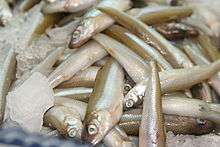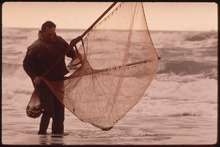Smelt (fish)
| Smelt | |
|---|---|
 | |
| Pond smelt (Hypomesus olidus) | |
| Scientific classification | |
| Kingdom: | Animalia |
| Phylum: | Chordata |
| Class: | Actinopterygii |
| Order: | Osmeriformes |
| Family: | Osmeridae |
| Genera | |
|
Allosmerus | |
Smelts are a family of small fish, the Osmeridae, found in the Atlantic and Pacific Oceans. They are also known as freshwater smelts or typical smelts to distinguish them from the related Argentinidae, Bathylagidae, and Retropinnidae.
Some smelt species are common in the North American Great Lakes, and in the lakes and seas of the northern part of Europe, where they run in large schools along the saltwater coastline during spring migration to their spawning streams. In some western parts of the United States, smelt populations have greatly declined in recent decades, leading to their protection under the Endangered Species Act. The Delta smelt, Hypomesus transpacificus, found in the Sacramento Delta of California, and the Columbia River smelt, Eulachon, are both protected from harvest.
Some species of smelts are among the few fish that sportsmen have been allowed to net, using hand-held dip nets, either along the coastline or in streams. Some sportsmen also ice fish for smelt. They are often fried and eaten whole.
Description
In size, smelts usually grow to about 20 cm (7.9 in) long, although some species can reach 70 cm (28 in).[1] Smelts are a food source for many fish, including salmon, striped bass, and lake trout.
Like salmon, many species are anadromous, living most of their lives in the sea, but traveling into fresh water to breed. However, a few exceptions, such as the surf smelt, spend their entire lives at sea.[2]
| Family Osmeridae | |||||||||||||||||||||||||||||||||||||||
| |||||||||||||||||||||||||||||||||||||||
| Cladogram of the Osmeridae family. Salangidae and Plecoglossus might be sister clades to the osmerid genera.[3] |
Smelt dipping
In the Canadian provinces and U.S. states around the Great Lakes, "smelt dipping" is a common group sport in the early spring and when stream waters reach around 4 °C, (40–42 °F). Fish are spotted using a flashlight or headlamp and scooped out of the water using a dip net made of nylon or metal mesh. The smelt are cleaned by removing the head and the entrails. Fins, scales, and bones of all but the largest of smelts are cooked without removal.
On the Maine coast, smelts were also a sign of spring, with the run of these small fish up tiny tidal estuaries. Many of these streams were narrow enough for a person to straddle and get a good catch of smelt by dipping a bucket.
As food

North America
Smelts are an important winter catch in the saltwater mouths of rivers in New England and the Maritime Provinces of Canada. Fishermen would historically go to customary locations over the ice using horses and sleighs. Smelt taken out of the cold saltwater were preferred to those taken in warm water. The fish did not command a high price on the market, but provided a source of supplemental income due to their abundance. The smelts were "flash frozen" simply by leaving them on the ice and then sold to fish buyers who came down the rivers.
In present day, smelts are fished both commercially using nets at sea, and for recreation by hand-netting them or spearing or angling them through holes in river ice. They are often the target fish of small 'fishing shack' villages that spring up along frozen rivers. Typical ways of preparing them include pan-frying in flour and butter, or deep-frying in batter, and they are sometimes cooked directly out of the water over small stoves in the shacks.
East Asia
Smelt is popular in Japan, as the species Sprinchus lanceolatus, and is generally served grilled, called shishamo, especially when full of eggs.
Smelt roe, specifically from capelin, called masago in Japanese, is yellow to orange in color and is often used in sushi.
Smelt is also served in dim sum restaurants, deep fried with the heads and tails attached, identified as duō chūn yú (多春鱼) or duō luǎn yú (多卵魚), which loosely translates as "fish with many eggs".
Smelt is one of the prime fish species eaten in coastal Karnataka, especially in Mangalore and Udupi regions, usually fried with heads and tailed removed or in curries. They are called 'Bolingei' (ಬೊಳಂಜೆ) in Kannada and Tulu and 'MotiyaLe' in Konkani.[4]
Festivals

In the city of Inje, South Korea (Gangwon Province), an Ice Fishing Festival is held annually from January 30 to February 2 on Soyang Lake, coinciding with the smelt's yearly run into fresh water to spawn. They are locally known as bing-eo (빙어) and typically eaten alive or deep fried.
In Finland, the province of Paltamo has yearly Norssikarnevaali festivals in middle of May.
For some Italians, especially from the region of Calabria, fried smelts are a traditional part of Christmas Eve dinner consisting of multiple courses of fish.
In 1956, the Chamber of Commerce in Kelso, Washington, declared Kelso, located on the Cowlitz River, as the "Smelt Capital of the World". They erected billboards proclaiming this, and held festivals for the annual smelt runs, until the runs dried up.[5]
The village of Lewiston, New York, on the lower portion of the Niagara River, celebrates an annual two-day smelt festival the first weekend in May.[6][7] During the festival, approximately 350 pounds of smelt are battered and fried at the Lewiston Waterfront.[8] The smelt samples are free during the festival and donations are welcome, as they help support programs supported by the Niagara River Anglers. The festival has a motto, which is a play on words: "Lewiston never smelt so good." [9]
Lithuania celebrates an annual weekend smelt festival in Palanga "Palangos Stinta" early every January.
At the time of the smelt's spring run in the Neva River at the head of the Gulf of Finland on the Baltic Sea in Saint Petersburg, a Smelt Festival (Prazdnik korushki) is celebrated.
References
- ↑ Froese, Rainer, and Daniel Pauly, eds. (2012). "Osmeridae" in FishBase. February 2012 version.
- ↑ McDowell, Robert M. (1998). Paxton, J.R.; Eschmeyer, W.N., eds. Encyclopedia of Fishes. San Diego: Academic Press. p. 116. ISBN 0-12-547665-5.
- ↑ Molecular resolution of the systematics of a problematic group of fishes (Teleostei: Osmeridae) and evidence for morphological homoplasy, Katriina L. Ilves , Eric B. Taylor, Molecular Phylogenetics and Evolution 50 (2009) 163–178. doi:10.1016/j.ympev.2008.10.021
- ↑ "Fish Glossary". Flavours - The treasure house of recepies.
- ↑ Hinrichsen, Richard A (1998) "The Ghost Run of the Cowlitz" Cowlitz Historical Quarterly, 40 (2): 5–21.
- ↑ http://www.buffalonews.com/cityregion/niagaracounty/story/652177.html
- ↑ http://www.tonawanda-news.com/local/local_story_117011425.html
- ↑ http://www.buffalospree.com/Buffalo-Spree/Events/Calendar/index.php/name/Lewiston-Smelt-Festival/event/13495/
- ↑ http://www.niagarariverregion.com/event/100049/lewiston-never-smelt-so-good
External links
- Froese, Rainer, and Daniel Pauly, eds. (2006). "Osmeridae" in FishBase. January 2006 version.
